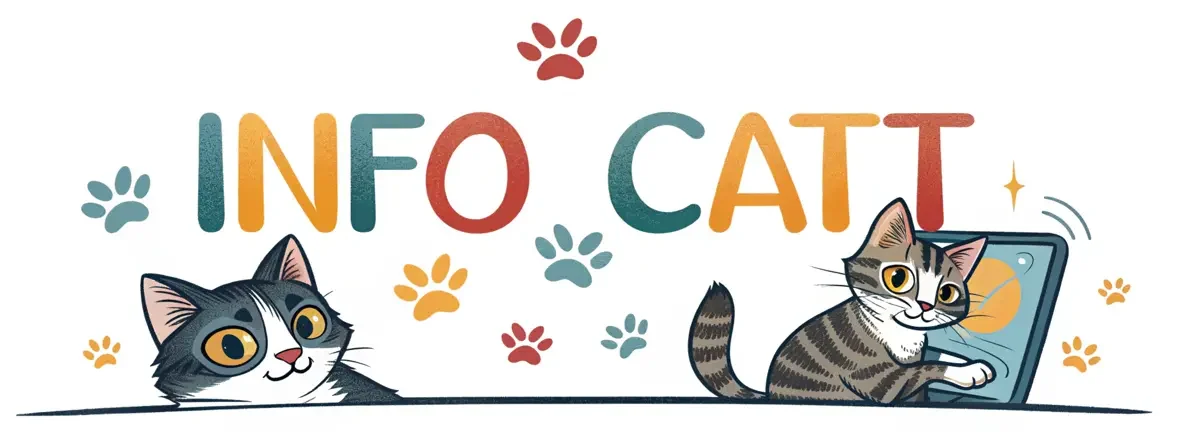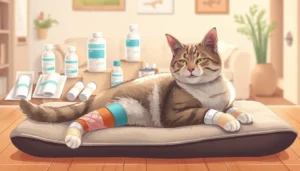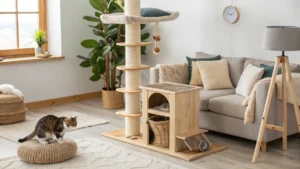When I saw my neighbor’s three-legged cat, Luna, run across her yard, I learned something important. Her missing back leg didn’t stop her from being full of joy. Taking care of a tripod cat means celebrating their amazing ability to adapt.
Bringing a three-legged cat home can feel daunting. It might seem like a big challenge to care for them. But, many pet owners have successfully given these cats loving homes. This guide will help you understand what your tripod kitty needs.
Caring for a three-legged cat needs patience, understanding, and special strategies. Whether their leg was lost due to injury, illness, or birth defect, they can still live a happy life. With the right support and approach, they can thrive.
Understanding Your Three-Legged Companion’s Special Needs
Caring for a cat with a missing leg needs special care and understanding. It’s more than just being a pet owner. Your special needs cat can do well with the right care and knowledge.
Learning about amputee cat tips starts with their story. Cats lose limbs for many reasons, each one unique to the cat.
Common Causes of Limb Loss
Three-legged cats often lose limbs due to:
- Traumatic accidents
- Severe medical conditions
- Congenital disabilities
- Surgical interventions
Physical Limitations and Capabilities
Despite missing a leg, these cats are amazingly adaptable. Your cat with missing leg will likely develop impressive compensation strategies. They can:
- Jump and climb effectively
- Maintain excellent balance
- Navigate spaces with surprising agility
Emotional Adjustment Period
Both you and your cat will go through an emotional change. Patience, love, and support help your special needs cat feel confident and adjust to their new reality.
Every three-legged cat is a testament to resilience and the incredible spirit of feline companions.
How to Take Care of a Tripod Cat: Essential Guidelines
Caring for a three-legged cat needs special attention and care. You must understand your pet’s unique needs. Create a comfortable space that helps with healing and moving around.
While caring for a tripod cat involves special attention to mobility and comfort, grooming is just as important. Here’s how to make your cat smell good without stressing them out.
Your tripod cat will need extra help getting used to their new body. Focus on these key areas for mobility support:
- Gentle physical therapy exercises
- Consistent pain management
- Specialized nutrition
- Regular veterinary check-ups
Adapting your home for a tripod cat means making small but important changes. Here are some practical tips:
- Create low-access resting areas
- Use non-slip mats in key spaces
- Provide supportive bedding
- Install gentle ramps near furniture
Patience and positive reinforcement are crucial during your cat’s recovery and adjustment period. Your love and support will help your three-legged friend feel confident and live well.
Remember, a tripod cat can live a happy, active life with the right care and attention.
Creating a Safe Home Environment for Your Tripod Cat
Bringing a three-legged cat home needs careful planning. You’ll want to make sure they’re comfortable and can move around easily. With the right changes, your cat can live happily and independently.
To help your three-legged cat move around safely, consider these important changes:
Strategic Living Space Adjustments
- Install non-slip mats on slick floors to prevent sliding
- Remove clutter and create clear pathways
- Place rugs with textured surfaces for better traction
- Block off stairs or add pet gates for safety
Selecting Optimal Cat Furniture
Choosing the right furniture is crucial for your cat’s mobility. Look for low-profile beds and stable scratching posts. Also, furniture with gentle inclines makes climbing easier.
Accessible Feeding and Bathroom Solutions
Finding the best litter box for tripod cats is important. Consider their unique needs. Opt for:
- Low-sided litter boxes with easy entry
- Raised food and water stations
- Multiple locations to minimize movement
Remember, patience and creativity are key in helping your three-legged companion feel secure and comfortable in their home environment.
Managing Your Tripod Cat’s Physical Health
Caring for a tripod cat means focusing on their physical health. It’s important to understand their unique challenges. This helps keep them healthy and happy.
Regular vet visits are key for disabled cat care. Your tripod cat needs extra checks to avoid health issues. Vets can look at:
- Muscle strength in remaining limbs
- Weight management strategies
- Potential joint stress indicators
- Mobility assessment
Keeping your cat at a healthy weight is vital. Extra pounds can hurt their remaining limbs and joints. Feeding them the right amount and a balanced diet helps avoid this.
Physical therapy and gentle exercises are also important. Talk to your vet about exercises for tripod cats. These might include:
- Gentle stretching routines
- Low-impact movement exercises
- Supervised physical activity
Look out for signs of discomfort or mobility changes. Catching issues early can stop long-term health problems for your special needs cat.
Exercise and Play Adaptations for Three-Legged Cats
Playtime for tripod cats is a bit different, but it’s still key for their health. They can enjoy fun activities that help with mobility and keep their minds sharp. It’s all about finding the right play that fits their special abilities.
Supporting a cat’s mobility needs creativity and patience. Your guide for caring for a tripod cat should include safe and fun play ideas.
Safe Play Activities
- Use soft toys that are easy to bat around
- Choose low-impact interactive games
- Engage in gentle wrestling and cuddling
- Create obstacle courses with minimal height
Recommended Toys and Equipment
Choose toys that help your cat move gently without hurting their remaining limbs. Some great picks include:
- Laser pointers for controlled movement
- Crinkle balls with soft textures
- Catnip mice with lightweight design
- Puzzle feeders to stimulate mental engagement
Exercise Duration and Intensity
Begin with short play sessions of 5-10 minutes. Pay attention to your cat’s energy and how they’re feeling. As they get stronger and more confident, you can slowly add more playtime. Remember, it’s the quality of play that counts for a tripod cat’s physical health.
Every tripod cat is unique – observe and adapt to your furry friend’s individual needs and preferences.
Preventing Common Health Issues in Tripod Cats
Caring for a three-legged cat means knowing about health challenges. With the right care, tripod cats can live long, happy lives. It’s important to meet their special needs and prevent problems.
Managing your cat’s weight is key. Losing a leg can stress their remaining limbs and joints. Your vet can create a diet plan that fits your cat’s needs.
- Monitor weight carefully to prevent additional joint strain
- Schedule regular veterinary check-ups
- Watch for signs of muscle imbalance or compensation behaviors
Muscle and joint health need extra care. Gentle exercises and physical therapy help keep muscles strong. Adaptive equipment like special harnesses or slings can offer support.
Early intervention and consistent care are the cornerstones of helping your tripod cat thrive.
Regular health checks are vital. Issues like arthritis or muscle problems can be caught and treated early. Understanding your cat’s needs greatly improves their life and how long they live.
Conclusion
Caring for a three-legged cat is a special experience. It’s more than just owning a pet. By understanding their behavior and needs, you can greatly improve their life.
Every small change you make helps your cat feel loved and supported. This creates a better environment for them to thrive.
Supporting a tripod pet starts with patience and empathy. They may face physical challenges, but with the right care, they can live a happy and active life. Seeing their strength and determination is truly inspiring.
Your dedication is key. By creating special environments and understanding their needs, you help your cat feel confident and independent. Their journey shows the strong bond between humans and animals.
Embrace this special bond with an open heart. Your tripod cat will be more than a pet; they’ll be a beloved family member. They’ll teach you about perseverance, love, and acceptance. Together, you’ll celebrate life in all its forms.
FAQ
How long can a tripod cat typically live?
Your three-legged cat can live as long as a four-legged one with the right care. They usually live 12-15 years. Make sure to give them special care, keep them at a healthy weight, and check their health early.
Do tripod cats experience pain after amputation?
At first, your cat might feel some pain. But most cats get used to it quickly. Your vet can help with a pain plan that includes medicine, therapy, and gentle care.
How can I help my tripod cat move around more easily?
Make your home easy for your cat to get around. Use ramps, non-slip surfaces, and place food and litter boxes where they can reach them. Your vet might suggest harnesses or mobility aids.
Will my tripod cat be able to play and be active?
Yes! Many three-legged cats are very playful and agile. Choose toys that don’t require too much movement. Play gently and at your cat’s pace.
Do tripod cats need special nutrition?
They don’t need a different diet, but a special nutrition plan can help. Keep them at a healthy weight and feed high-protein, low-fat foods to help their muscles.
How do I choose the right litter box for a three-legged cat?
Look for litter boxes with low entry points. You can also use a shallow, wide box. Some cats do well with ramp-style or low-sided boxes.
What are the most common causes of limb loss in cats?
Cats lose limbs due to trauma, infections, cancer, fractures, or birth defects. Each case is different, but most cats adapt well to their new body.
How can I emotionally support my tripod cat during recovery?
Be gentle, consistent, and patient. Keep your home calm and give lots of positive reinforcement. This will help your cat feel loved and secure.
Are there any specific health issues I should watch for with a tripod cat?
Watch for muscle strain, joint stress, and weight issues. Regular vet visits are key. Look for signs of overuse and keep your cat’s health in check.
Can tripod cats climb and jump like other cats?
Many three-legged cats are very adaptable. They might not jump as high or climb as easily, but they find ways to adapt. Help them with cat trees and ramps when needed.



